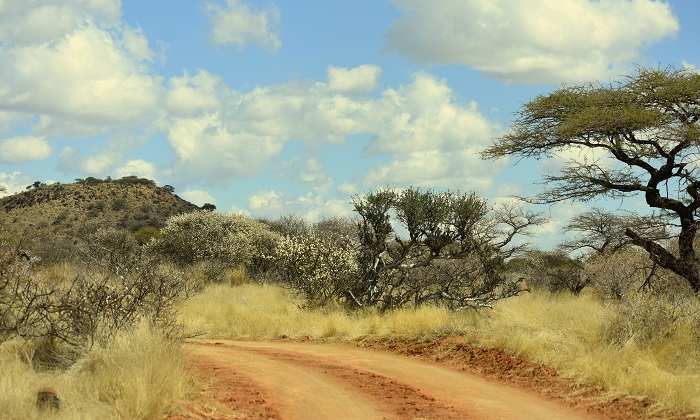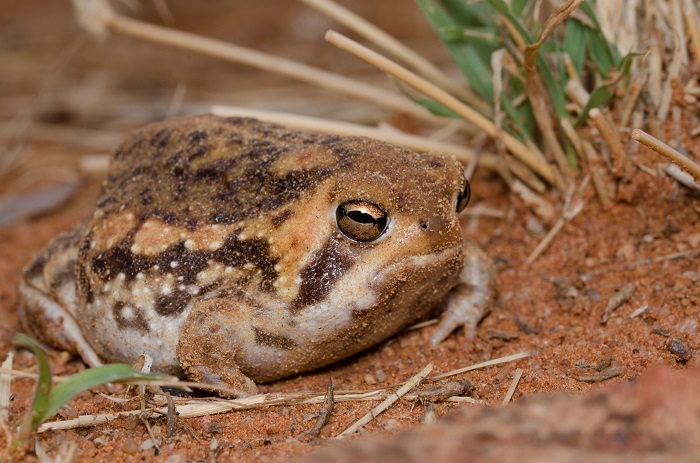Cover photo by Kyle Finn.
Find the Bushveld Rain Frog in the FBIS database (Freshwater Biodiversity Information System) here.
Family Brevicepitidae
Identification

Near Hoedspruit, Limpopo
Photo by Alison Sharp
The Bushveld Rain Frog is a medium-sized species. Males attain 47mm in length, while females can reach 60mm. The limbs are stubby and the head is short. The dorsal surface is rough and granular, with variable colourations and patterning, but is most often brown with paired paler, yellowish patches. Variable darker markings are also present, including a blackish stripe running from the eye toward the armpit. The undersides are smooth and white with some darker mottling and two black patches on the throat.
Habitat
The Bushveld Rain Frog inhabits seasonally dry to semi-arid habitats in the Savanna Biome, with sandy to sandy-loam soils. It is particularly associated with bushveld vegetation types that are characterised by “a grassy ground layer and a distinct upper layer of woody plants” (Low and Rebelo 1996). It is conspicuously absent from the Grassland and Forest biomes.
The subspecies B. a. pentheri occurs in Eastern Thorn Bushveld, Spekboom Succulent Thicket, and Valley Thicket. In Polokwane and Grahamstown, parks and gardens with well-turned, sandy soil contain breeding populations of both B. a. adspersus and B. a. pentheri, indicating that this species can survive in a suburban environment.

Photo by Karis Daniel
Behaviour
Bushveld Rain Frogs spend the winter dry season 15–30 cm below the surface, often in situations where soil moisture is conserved, for example, next to or under rocks, logs, stumps, or tree roots (Jacobsen 1989; pers. obs.).
In spring or early summer, following heavy rain, male Bushveld Rain Frogs emerge from the soil and establish call sites 5–200 cm from their winter retreats. The call site usually consists of a well-concealed shallow depression, about the depth of the frog’s body, at the base of a grass tuft or small herbaceous plant. In overcast, damp conditions, calling may continue unchecked for several days and nights. Males are prompted to call by the calls of their immediate neighbours, and this results in bouts of calling which spread through the population in waves. When hot, dry weather returns, or when disturbed, males retreat to their underground burrows. Males were observed to use the same call site for up to five consecutive nights (Minter 1995, 1998).
Amplexus is facilitated by a sticky skin secretion which ensures that the male remains attached to the female during nest construction. A mass of about 45 eggs, covered by a smaller mass of fluid-filled jelly capsules lacking yolk, is deposited in a chamber about 30 cm below the surface. The female remains nearby until the froglets are ready to leave the nest (approximately six weeks). The reason for her presence has not been established (Minter 1995, 1998).

Witsand Nature Reserve, Northern Cape
Photo by Vaughan Jessnitz
Status and Conservation
The Bushveld Rain Frog does not appear to be at risk as much of its habitat is used for game and cattle farming, and is relatively undisturbed. It also occurs in a number of provincial nature reserves and national parks.
Distribution
Beyond the atlas region, the Bushveld Rain Frog occurs in Namibia, Botswana, Zimbabwe, southern Zambia, and Mozambique (Poynton and Broadley 1985a). In the atlas region, the subspecies B. a. adspersus occurs in its preferred habitat throughout most of Limpopo and North West provinces, the northern Free State, the eastern parts of the Northern Cape, Gauteng, Mpumalanga, and central and eastern eSwatini (Swaziland). In KwaZulu-Natal, it is found at lower elevations, as far south as Margate (3030CD).
Call data and molecular evidence (Minter 1998; Engelbrecht and Mulder 2000) support the retention of the subspecies B. a. pentheri in the Eastern Cape, where it is distributed from Joubertina (3323DD) inland to Grahamstown (3326BC), and northward as far as the Stutterheim district (3227BC). Populations from the Great Escarpment of KwaZulu-Natal and Mpumalanga, e.g., near Wakkerstroom (2730AD), previously referred to B. a. pentheri by Poynton (1964), were assigned to B. mossambicus on the basis of advertisement call structure (Minter 1998).

Light paravertebral and dorsolateral patches on the dorsum of the Bushveld Rain Frog distinguish this species from northern Mozambique populations of B. mossambicus, which lack these markings (Poynton 1964; Poynton and Broadley 1985a; Lambiris 1989a; Minter 1998). However, this is not the case in the atlas region, where similar markings are present in B. sopranus, B. bagginsi, and in populations of B. mossambicus from the Great Escarpment and coastal KwaZulu-Natal (see B. mossambicus species account).
A study of advertisement calls (Minter 1998) did not support the hypothesis that B. adspersus and B. mossambicus hybridize extensively in KwaZulu-Natal (Poynton 1964; Poynton and Broadley 1985a; Lambiris 1989a). The hybridization hypothesis was based on dorsal markings that do not constitute a reliable diagnostic character. Therefore, existing museum and literature records of B. adspersus from KwaZulu-Natal, unless based on advertisement calls, should be regarded as unreliable. A survey based on advertisement calls is needed in order to re-map the distribution of B. adspersus in the northeastern parts of the atlas region, and the atlas data from the pre-1996 period should be viewed with circumspection.
Further Resources
The use of photographs by Alison Sharp, Kyle Finn, Karis Daniel, and Vaughan Jessnitz is acknowledged.
Bushveld Rain Frog Breviceps adspersus Peters, 1882
Other Common Names: Common Rain Frog (Alt. English); Bosveld Reenpadda (Afrikaans)
Recommended citation format: Minter, LR; Tippett, RM. (2025). Bushveld Rain Frog Breviceps adspersus. Biodiversity and Development Institute, Cape Town. Available online at https://thebdi.org/2022/01/24/bushveld-rain-frog-breviceps-adspersus/
This species text has been updated and expanded from the text in the
2004 frog atlas: Minter, LR. (2004). Bushveld Rain Frog Breviceps adspersus. In Minter LR et al 2004.
References:
Minter, LR; Burger, M; Harrison, JA; Braack, HH; Bishop, PJ; Kloepfer, D. (Editors). (2004). Atlas and Red Data Book of the Frogs of South Africa, Lesotho and Swaziland. Smithsonian Institution, Washington, and Avian Demography
Unit, Cape Town.
Carruthers, V; du Preez, L. (2017). Frogs of southern Africa: A Complete Guide. Struik Nature, Cape Town.
Channing, A. (2001) Amphibians of Central and Southern Africa. Protea Book House, Pretoria
Claus, B; Claus, R. (2002). Common Amphibians and Reptiles of Botswana. Gamsberg Macmillan, Windhoek.

